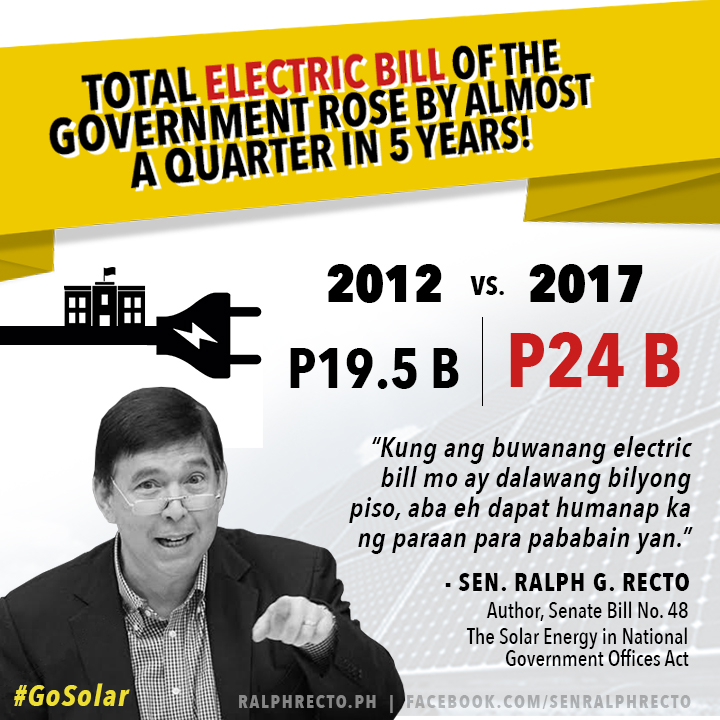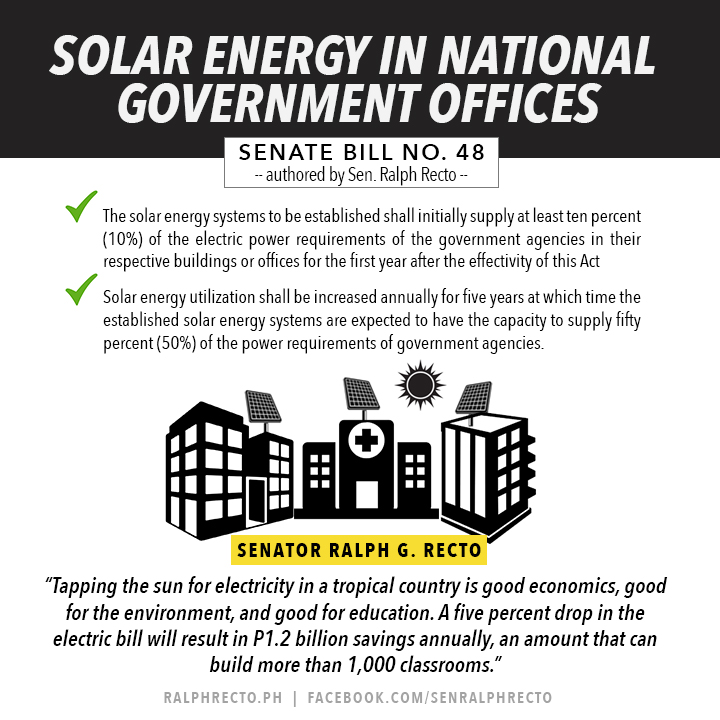Solar panels in public buildings can cut govt’s P24 B—and growing—yearly electric bill
Government buildings now consume at least P24 billion worth of electricity a year, an amount that is growing by P1 billion annually, prompting Senate President Pro Tempore Ralph Recto to file a bill calling for the installation of solar power systems in public buildings.
Recto said the government’s electric bill reached P24 billion in 2017, P11.4 billion of which was incurred by national government agencies while P12.6 billion was racked up by local governments.
To compare, national agencies and local governments paid a total of P19.5 billion in 2012, which means that their total electric bill rose by almost a quarter in five years.

“Kung ang buwanang electric bill mo ay dalawang bilyong piso, aba eh dapat humanap ka ng paraan para pababain yan,” Recto said.
“Tapping the sun for electricity in a tropical country is good economics, good for the environment, and good for education,” he said.“A five percent drop in the electric bill will result in P1.2 billion savings annually, an amount that can build more than 1,000 classrooms,” he added.
Harping on solar energy’s green credentials, Recto said it does not generate greenhouse gases such as carbon, nor emit particulates that are the bane of fossil fuels.
He said installing solar panels in public schools will not only provide power to classrooms, but also skills and training to senior high school students who are enrolled in the technical-vocational track as well.
Recto said 4,000 schools are energy-starved largely because they are far from power grids. “Kung walang kuryente, walang umaandar na computer at tech-voc equipment. But solar power can end their permanent state of power blackout.”Due to the advent of computerization and the expansion of night classes in urban schools, the Department of Education’s electricity bill soared by 137 percent between 2012 to 2017, from P951 million to almost P2.3 billion.
National government hospitals have also seen their power consumption spike by 50 percent between 2012 to 2017 when they paid almost P1.2 billion.
Recto said installing solar power systems on the roof of school buildings, grounds of military camps, state college campuses is not rocket science as “both the technology and price have been democratized.”
“It is a complementary and supplementary source. Nakakabit pa rin ang building sa grid,” Recto stressed.“But during calamities when the grid is down, it can independently generate electricity —maybe not enough to meet the demand of a building, but having little is better than none at all,” Recto said.
Recto’s proposed “Solar Energy in National Government Offices Act” provides the mechanism for an efficient, cost-effective and sustainable supply of power from solar energy systems in the bureaucracy.
It sets a timetable for the minimum share of solar power in government electricity consumption, setting an ambitious 10 percent during the pilot phase.

Another benefit of having solar panels in government properties “and seeing them work is that they will serve as demonstration units that will show the public that this clean and cheap source of power is viable.”

